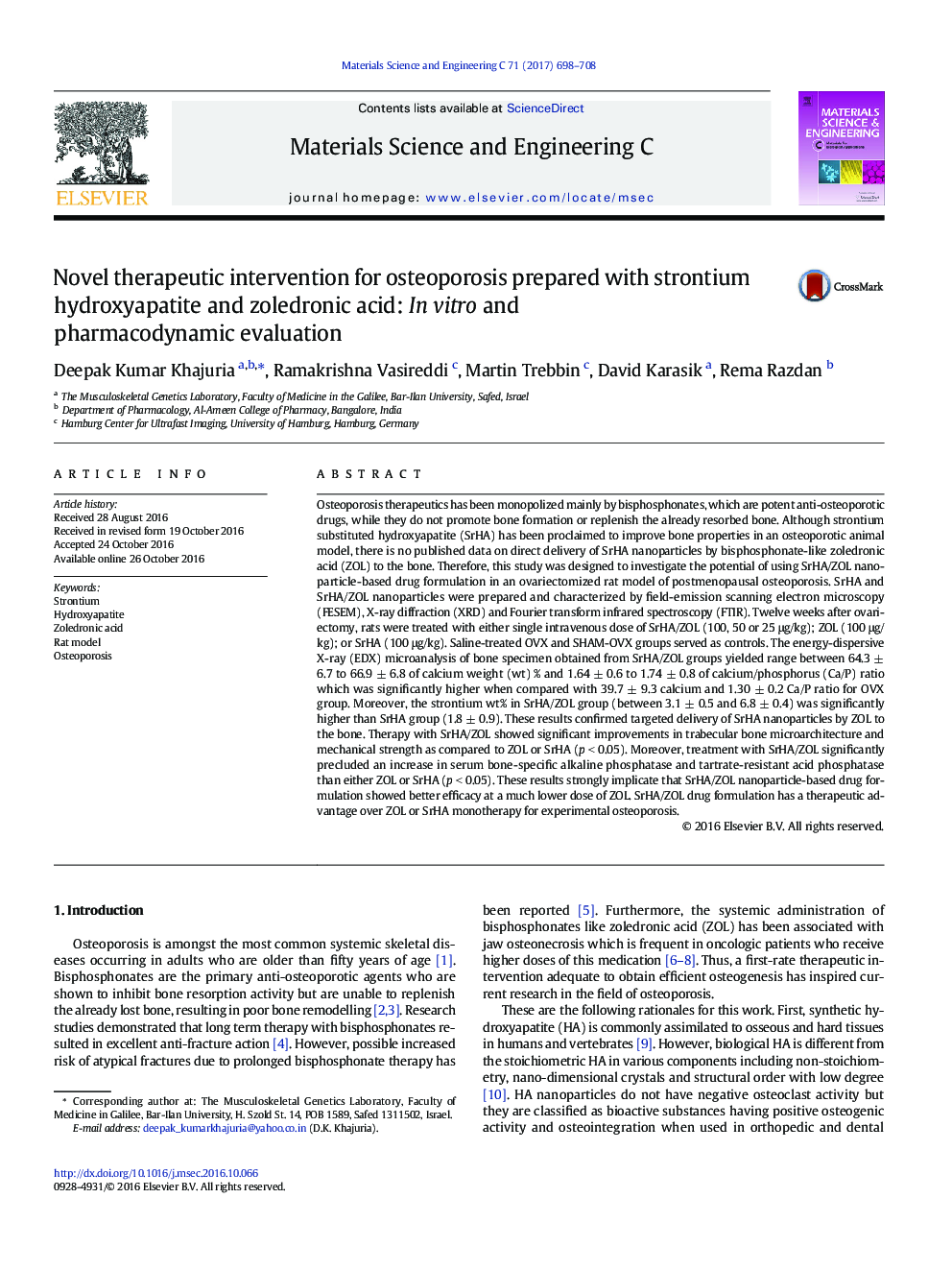| کد مقاله | کد نشریه | سال انتشار | مقاله انگلیسی | نسخه تمام متن |
|---|---|---|---|---|
| 5434677 | 1509150 | 2017 | 11 صفحه PDF | دانلود رایگان |
- Nanoparticles of strontium-hydroxyapatite (SrHA) loaded with zoledronic acid (ZOL) were prepared.
- ZOL was used as a carrier to deliver SrHA nanoparticles to bones.
- SrHA/ZOL nanoparticle based drug formulation was tested in a rat model of postmenopausal osteoporosis.
- SrHA/ZOL therapy showed significant improvement in bone properties.
Osteoporosis therapeutics has been monopolized mainly by bisphosphonates, which are potent anti-osteoporotic drugs, while they do not promote bone formation or replenish the already resorbed bone. Although strontium substituted hydroxyapatite (SrHA) has been proclaimed to improve bone properties in an osteoporotic animal model, there is no published data on direct delivery of SrHA nanoparticles by bisphosphonate-like zoledronic acid (ZOL) to the bone. Therefore, this study was designed to investigate the potential of using SrHA/ZOL nanoparticle-based drug formulation in an ovariectomized rat model of postmenopausal osteoporosis. SrHA and SrHA/ZOL nanoparticles were prepared and characterized by field-emission scanning electron microscopy (FESEM), X-ray diffraction (XRD) and Fourier transform infrared spectroscopy (FTIR). Twelve weeks after ovariectomy, rats were treated with either single intravenous dose of SrHA/ZOL (100, 50 or 25 μg/kg); ZOL (100 μg/kg); or SrHA (100 μg/kg). Saline-treated OVX and SHAM-OVX groups served as controls. The energy-dispersive X-ray (EDX) microanalysis of bone specimen obtained from SrHA/ZOL groups yielded range between 64.3 ± 6.7 to 66.9 ± 6.8 of calcium weight (wt) % and 1.64 ± 0.6 to 1.74 ± 0.8 of calcium/phosphorus (Ca/P) ratio which was significantly higher when compared with 39.7 ± 9.3 calcium and 1.30 ± 0.2 Ca/P ratio for OVX group. Moreover, the strontium wt% in SrHA/ZOL group (between 3.1 ± 0.5 and 6.8 ± 0.4) was significantly higher than SrHA group (1.8 ± 0.9). These results confirmed targeted delivery of SrHA nanoparticles by ZOL to the bone. Therapy with SrHA/ZOL showed significant improvements in trabecular bone microarchitecture and mechanical strength as compared to ZOL or SrHA (p < 0.05). Moreover, treatment with SrHA/ZOL significantly precluded an increase in serum bone-specific alkaline phosphatase and tartrate-resistant acid phosphatase than either ZOL or SrHA (p < 0.05). These results strongly implicate that SrHA/ZOL nanoparticle-based drug formulation showed better efficacy at a much lower dose of ZOL. SrHA/ZOL drug formulation has a therapeutic advantage over ZOL or SrHA monotherapy for experimental osteoporosis.
274
Journal: Materials Science and Engineering: C - Volume 71, 1 February 2017, Pages 698-708
